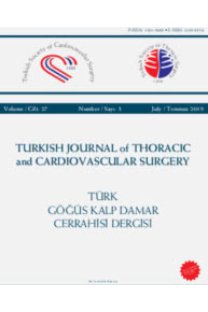The effect of the number of dissected lymph nodes on survival in patients operated on for T1a-T2a N0 non-small cell lung cancer
T1a-T2a N0 küçük hücreli dışı akciğer kanseri nedeni ile ameliyat edilmiş hastalarda diseke edilen lenf nodu sayısının sağkalım üzerine etkisi
___
- Ferlay J, Shin HR, Bray F, Forman D, Mathers C, Parkin DM. Estimates of worldwide burden of cancer in 2008: GLOBOCAN 2008. Int J Cancer 2010;127:2893-917.
- American Joint Committee on Cancer. AJCC cancer staging manual. 7th ed. New York: Springer; 2008. p. 251-9.
- Oda M, Watanabe Y, Shimizu J, Murakami S, Ohta Y, Sekido N, et al. Extent of mediastinal node metastasis in clinical stage I non-small-cell lung cancer: the role of systematic nodal dissection. Lung Cancer 1998;22:23-30.
- Koike T, Terashima M, Takizawa T, Watanabe T, Kurita Y, Yokoyama A. Clinical analysis of small-sized peripheral lung cancer. J Thorac Cardiovasc Surg 1998;115:1015-20.
- Naruke T, Tsuchiya R, Kondo H, Nakayama H, Asamura H. Lymph node sampling in lung cancer: how should it be done? Eur J Cardiothorac Surg 1999;16:17-24.
- Ou SH, Zell JA. Prognostic significance of the number of lymph nodes removed at lobectomy in stage IA non-small cell lung cancer. J Thorac Oncol 2008;3:880-6.
- Okada M, Sakamoto T, Yuki T, Mimura T, Miyoshi K, Tsubota N. Selective mediastinal lymphadenectomy for clinico-surgical stage I non-small cell lung cancer. Ann Thorac Surg 2006;81:1028-32.
- Darling GE, Allen MS, Decker PA, Ballman K, Malthaner RA, Inculet RI, et al. Number of lymph nodes harvested from a mediastinal lymphadenectomy: results of the randomized, prospective American College of Surgeons Oncology Group Z0030 trial. Chest 2011;139:1124-9.
- Colice GL, Shafazand S, Griffin JP, Keenan R, Bolliger CT. Physiologic evaluation of the patient with lung cancer being considered for resectional surgery: ACCP evidenced-based clinical practice guidelines (2nd edition). Chest 2007;132:161-77.
- Doddoli C, Aragon A, Barlesi F, Chetaille B, Robitail S, Giudicelli R, et al. Does the extent of lymph node dissection influence outcome in patients with stage I non-small-cell lung cancer? Eur J Cardiothorac Surg 2005;27:680-5.
- Massard G, Ducrocq X, Kochetkova EA, Porhanov VA, Riquet M. Sampling or node dissection for intraoperative staging of lung cancer: a multicentric cross-sectional study. Eur J Cardiothorac Surg 2006;30:164-7.
- Gaer JA, Goldstraw P. Intraoperative assessment of nodal staging at thoracotomy for carcinoma of the bronchus. Eur J Cardiothorac Surg 1990;4:207-10.
- Feinstein AR, Sosin DM, Wells CK. The Will Rogers phenomenon. Stage migration and new diagnostic techniques as a source of misleading statistics for survival in cancer. N Engl J Med 1985;312:1604-8.
- Goldstraw P. Report on the international workshop on intrathoracic staging. Lung Cancer 1997;18:107-11.
- Gajra A, Newman N, Gamble GP, Kohman LJ, Graziano SL. Effect of number of lymph nodes sampled on outcome in patients with stage I non-small-cell lung cancer. J Clin Oncol 2003;21:1029-34.
- Ludwig MS, Goodman M, Miller DL, Johnstone PA. Postoperative survival and the number of lymph nodes sampled during resection of node-negative non-small cell lung cancer. Chest 2005;128:1545-50.
- Whitson BA, Groth SS, Maddaus MA. Surgical assessment and intraoperative management of mediastinal lymph nodes in non-small cell lung cancer. Ann Thorac Surg 2007;84:1059-65.
- Cho S, Song IH, Yang HC, Kim K, Jheon S. Predictive factors for node metastasis in patients with clinical stage I non-small cell lung cancer. Ann Thorac Surg 2013;96:239-45.
- Lee JG, Lee CY, Park IK, Kim DJ, Park SY, Kim KD, et al. Number of metastatic lymph nodes in resected non-small cell lung cancer predicts patient survival. Ann Thorac Surg 2008;85:211-5.
- Cerón J, Peñalver JC, Jordá C, Padilla J. Stage IB non-small cell lung cancer: impact of the number of lymph nodes examined on survival. Arch Bronconeumol 2009;45:87-91. [Abstract]
- Padilla J, Peñalver JC, Jordá C, Calvo V, Escrivá J, Cerón J, et al. Non-small cell bronchogenic cancer in stage IA: mortality patterns after surgery. Arch Bronconeumol 2005;41:180-4. [Abstract]
- Riquet M, Legras A, Mordant P, Rivera C, Arame A, Gibault L, et al. Number of mediastinal lymph nodes in non-small cell lung cancer: a Gaussian curve, not a prognostic factor. Ann Thorac Surg 2014;98:224-31.
- Wu N, Yan S, Lv C, Li S, Feng Y, Wang Y, et al. Does an extended mediastinal lymphadenectomy improve outcome after R0 resection in lung cancer? Chin J Cancer Res 2014;26:183-91.
- Izbicki JR, Passlick B, Pantel K, Pichlmeier U, Hosch SB, Karg O, et al. Effectiveness of radical systematic mediastinal lymphadenectomy in patients with resectable non-small cell lung cancer: results of a prospective randomized trial. Ann Surg 1998;227:138-44.
- Ludwig MS, Goodman M, Miller DL, Johnstone PA. Postoperative survival and the number of lymph nodes sampled during resection of node-negative non-small cell lung cancer. Chest 2005;128:1545-50.
- ISSN: 1301-5680
- Yayın Aralığı: 4
- Başlangıç: 1991
- Yayıncı: Bayçınar Tıbbi Yayıncılık
Late thoracic endovascular stent graft repair after complicated acute type B dissection
Sedat ÖZCAN, Ayşegül KUNT, Dolunay ODABAŞI
Ünal AYDIN, Ersin KADİROĞULLARI, İhsan BAKIR, Burak ONAN
Diyafragmatik kist hidatiğin ilginç bir görünümü
Atila EROĞLU, Yener AYDIN, Hayri OĞUL, Bayram ALTUNTAŞ
Popliteal artery entrapment syndrome needs an interdisciplinary approach
Emre GÖK, Tolga DEMİR, Oğuz KAYIRAN, Mazlum ŞAHİN, Murat Güçlü ELEVLİ
Soner GÜRSOY, Onur AKÇAY, Ozan USLUER, Özgür SAMANCILAR, Şeyda Örs KAYA, Suat Seren Chest DİSEASES
Karotis endarterektomide eksternal juguler ven yama plastinin orta ve uzun dönem sonuçları
Berk ARAPİ, Caner ARSLAN, Hasan TÜZÜN, Safa GÖDE, Kazım BEŞİRLİ
Pompa destekli atan kalpte baypas yönteminin avantajları nelerdir?
Levent YILIK, Ali GÜRBÜZ, Orhan GÖKALP
Synchronous bilateral thoracoscopic lobectomy in a patient with bronchiectasis
Ali ÖZDİL, Alpaslan ÇAKAN, Kutsal TURHAN, Ufuk ÇAĞIRICI, Yeliz EROL
Mehmet ACIPAYAM, Levent ALTINAY, Hasan UNCU, Ümit HALICI, Ahmet ÇAKALLIOĞLU, Pınar DOĞAN, Mehmet Alaaddin PEKEDİS, Gür Deniz YILDIZ, İbrahim ÖZSÖYLER
Short- and mid-term results of resection of discrete subaortic stenosis in children
Muhammet AKYÜZ, Ertürk LEVENT, Yüksel ATAY, Soysal TURHAN, Ruhi ÖZYÜREK, Onur IŞIK, Emin Alp ALAYUNT, Mehmet Fatih AYIK
